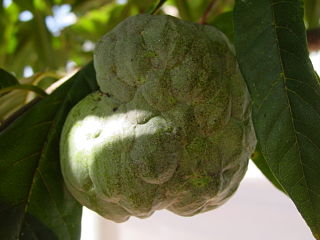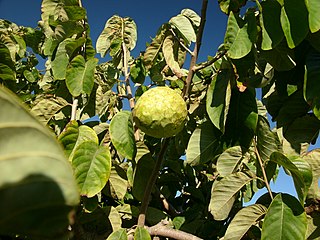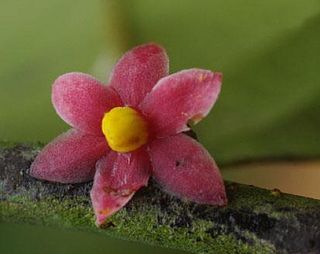
The Magnoliales are an order of flowering plants.

Soursop is the fruit of Annona muricata, a broadleaf, flowering, evergreen tree. It is native to the tropical regions of the Americas and the Caribbean and is widely propagated. It is in the same genus, Annona, as cherimoya and is in the Annonaceae family.

The Annonaceae are a family of flowering plants consisting of trees, shrubs, or rarely lianas commonly known as the custard apple family or soursop family. With 108 accepted genera and about 2400 known species, it is the largest family in the Magnoliales. Several genera produce edible fruit, most notably Annona, Anonidium, Asimina, Rollinia, and Uvaria. Its type genus is Annona. The family is concentrated in the tropics, with few species found in temperate regions. About 900 species are Neotropical, 450 are Afrotropical, and the remaining are Indomalayan.

The cherimoya, also spelled chirimoya and called chirimuya by the Inca people, is a species of edible fruit-bearing plant in the genus Annona, from the family Annonaceae, which includes the closely related sweetsop and soursop. The plant has long been believed to be native to Ecuador and Peru, with cultivation practised in the Andes and Central America, although a recent hypothesis postulates Central America as the origin instead, because many of the plant's wild relatives occur in this area.

Annona or Anona is a genus of flowering plants in the pawpaw/sugar apple family, Annonaceae. It is the second largest genus in the family after Guatteria, containing approximately 166 species of mostly Neotropical and Afrotropical trees and shrubs.

Custard apple is a common name for several fruits and may refer to Annonaceae, the custard apple family, which includes the following species referred to as custard apples:

Annona glabra is a tropical fruit tree in the family Annonaceae, in the same genus as the soursop and cherimoya. Common names include pond apple, alligator apple, swamp apple, corkwood, bobwood, and monkey apple. The tree is native to Florida in the United States, the Caribbean, Central and South America, and West Africa. It is common in the Everglades. The A. glabra tree is considered an invasive species in Sri Lanka and Australia. It grows in swamps, is tolerant of saltwater, and cannot grow in dry soil.

Degeneria is a genus of flowering plants endemic to Fiji. It is the only genus in the family Degeneriaceae. The APG IV system of 2016, recognizes this family, and assigns it to the order Magnoliales in the clade magnoliids.

Eupomatia is a genus of three species of plants in the ancient family Eupomatiaceae, and is the sole genus in the family. Eupomatiaceae is recognised by most taxonomists and classified in the plant order Magnoliales. The three described species are shrubs or small trees, native to the rainforests and humid eucalypt forests of eastern Australia and New Guinea. The type species Eupomatia laurina was described in 1814 by Robert Brown.

Asimina triloba, the American papaw, pawpaw, paw paw, or paw-paw, among many regional names, is a small deciduous tree native to the eastern United States and southern Ontario, Canada, producing a large, yellowish-green to brown fruit. Asimina is the only temperate genus in the tropical and subtropical flowering plant family Annonaceae, and Asimina triloba has the most northern range of all. Well-known tropical fruits of different genera in family Annonaceae include the custard-apple, cherimoya, sweetsop, ylang-ylang, and soursop.

The Cenepa River is a 185-kilometre (115 mi) stretch of river whose basin borders Ecuador and Peru, in the Cordillera del Cóndor mountain range in South America. Its drainage basin borders to the north on Ecuador, to the east on the districts of Río Santiago and Nieva in Peru, on the south with the district of Imaza, and on the west with Ecuador. The River has been subject to several border disputes between Peru and Ecuador; the most notable was the Cenepa War in 1995. The Awajún, the locals around the Cenepa River Basin, have had issues with the legal certainty of the River due to its cultural significance and resources. The Cenepa River has been impacted by the consequences of military action in the region through skirmishes between Ecuadorian and Peruvian forces along with the establishment of military camps and outposts. Expansion of local communities and the influence of mining have to different degrees interrupted the natural habitats of local fauna and flora. The Cenepa River has had government intervention through the growing recognition of the importance of preservation. This was a direct result of the peace talks that followed the Cenepa War in 1995, also known as the Alto Cenepa War.

Goniothalamus is one of the largest palaeotropical genera of plant in family Annonaceae.

Mosannona is a genus of flowering plants in the family Annonaceae. There are about 14 species native to the Neotropics, distributed from Mexico through Central America and South America particularly in rainforest surrounding the Andes.
Pseudoxandra williamsii is a species of plant in the Annonaceae family. It is endemic to Peru. Robert Elias Fries, the Swedish botanist who first formally described the species using the basionym Cremastosperma williamsii, named it after Llewelyn W. Williams, the Welsh economic botanist, who collected the holotype specimen he examined.

Uvariopsis is a genus of flowering plants in the family Annonaceae. The genus is unique to Africa, and consists of about 18 species, all of which are either ramiflorous, cauliflorous or both.

Sirdavidia is a monotypic genus of flowering plants from the family Annonaceae described February 4, 2015, by Thomas L.P. Couvreur of France's Institute of Research for Development, Raoul Niangadouma of the Herbier National du Gabon, Bonaventure Sonké of the University of Yaoundé, and Hervé Sauquet of Université Paris-Sud. The genus was named in honor of Sir David Attenborough. The type species Sirdavidia solannona was discovered and collected in Gabon in Crystal Mountains National Park on November 15, 2013, at elevations of 300–600 meters. The species name refers to the resemblance of the flowers to those of Solanum species.

Cremastosperma is a genus of flowering plants in the family Annonaceae, subfamily Malmeoideae, tribe Malmeae. In 2018 there were 34 recognised species distributed in Central and South America.

Cremastosperma cauliflorum is a species of plant in the family Annonaceae. It is native to Brazil, Colombia, Ecuador and Peru. Robert Elias Fries, the Swedish botanist who first formally described the species, named it after its flowers which grow from its main trunk or stem.

The Malmeoideae are a subfamily of trees and other plants of the family Annonaceae.

Custard Apple (Annonaceae), Breadfruit (Moraceae) and Soursop (Annonaceae) are three sculptures by Veronica Ryan that stand on Narrow Way, near St Augustine's Tower in Hackney, London. They were commissioned as a memorial to the Windrush generation of British African-Caribbean people who immigrated to the United Kingdom in the wake of World War II. They are the first permanent public sculptures by a black female artist in the United Kingdom.



















